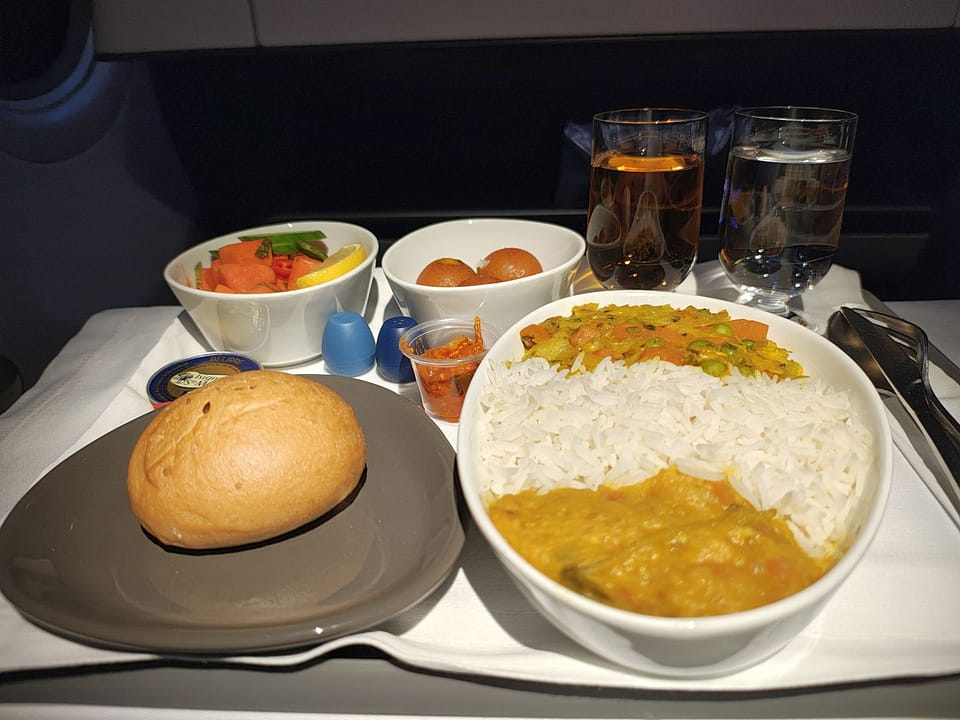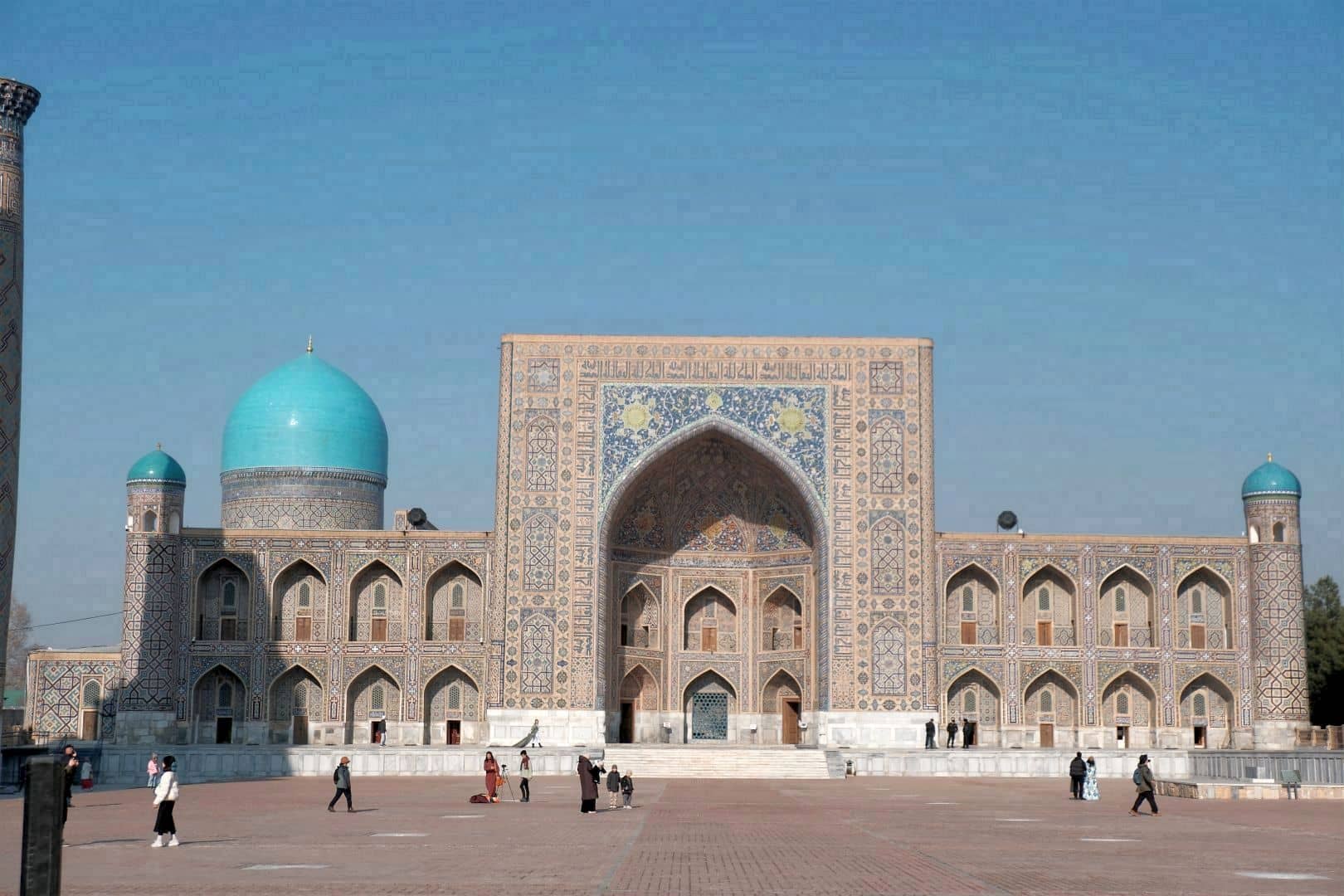We landed in Samarkand early in the morning, eager to explore one of Central Asia’s most historically rich cities. On our journey to Samarkand, we were upgraded to business class through a bidding offer. While the upgrade didn’t include lounge access or other ground facilities, we did enjoy a better in-flight dinner, making the experience more comfortable. Known for its awe-inspiring Islamic architecture, Samarkand has long been a crossroads of cultures, and the moment we set foot in the city, we could feel its deep history in the air. The formalities at the immigration were a breeze since we already had the e-visa handy. The driver was waiting for us and dropped us at our hotel for an early check-in.

Amir Temur Mausoleum
After a quick breakfast, we began our sightseeing tour of Samarkand, with our first stop at the Amir Temur Mausoleum. The Amir Temur Mausoleum, also known as Gur-e-Amir, is one of Samarkand’s most iconic landmarks. Built in the 15th century, it houses the tomb of Timur (Tamerlane), along with his descendants. The mausoleum’s striking blue dome, ornate mosaics, and intricate calligraphy make it a masterpiece of Timurid architecture. Stepping inside, the dimly lit chamber exudes an air of reverence, with jade tombstones marking the resting places of Timur and his family. This site not only showcases the grandeur of his empire but also serves as a symbol of Samarkand’s rich heritage.



Registan Square
The next stop was Registan Square. The Registan Square is the cultural and architectural heart of Samarkand, embodying the city’s historical significance as a centre of learning and artistry. Surrounded by three magnificent madrasahs, it once served as a bustling hub for scholars, merchants, and public gatherings, leaving behind a legacy of grandeur and intellectual pursuit.
Ulugbek Madrasah (Left)
The Ulugbek Madrasah, the oldest of the three, was built in the early 15th century by Ulugbek, the renowned astronomer and ruler of Samarkand. This madrasah was not just a religious school but also a centre of learning, where subjects like astronomy, mathematics, and philosophy were taught. Its facade features intricate geometric patterns and calligraphy, while the interior once housed scholars and students who contributed to the city’s intellectual legacy.


Tilya-Kori Madrasah (Center)
Situated in the centre of Registan Square, the Tilya-Kori Madrasah was built in the 17th century and served both as an educational institution and a grand mosque. Its name, meaning “gold-covered,” comes from the lavish gold decorations that adorn its interior. The mosque’s prayer hall is particularly breathtaking, with a domed ceiling covered in shimmering gold leaf, creating an illusion of endless depth. Its symmetrical courtyard and beautifully restored blue-tiled facade make it one of the most visually striking structures in Samarkand.


Sherdor Madrasah (Right)
The Sherdor Madrasah, built in the 17th century, mirrors the Ulugbek Madrasah in design but stands out with its bold imagery. The Madrasah’s facade features a striking and unconventional motif—two fierce tigers, each with a rising sun on its back, stalking white deer. This imagery, rare in Islamic architecture due to the prohibition of depicting living beings, symbolizes strength, power, and the pursuit of knowledge, reflecting the ambitions of its builder, Yalangtush Bakhodur. Though it was primarily a place of religious and academic study, the Sherdor Madrasah’s artistic elements add a unique flair to Registan Square’s harmonious ensemble.


A short fifteen-minute stroll brought us to the Bibi-Khanum Mosque. Strolling between the two allows you to take in the city’s vibrant streets, local shops, and historic atmosphere. Battery operated cars are available if needed.
Bibi-Khanum Mosque
The Bibi-Khanum Mosque, one of the largest and most impressive mosques in Central Asia, stands as a testament to the grandeur of Timur’s empire. Built in the late 14th century, it was intended to be the most magnificent mosque of its time, commissioned by Timur after his successful campaigns in India. The massive entrance portal, intricate tilework, and towering blue domes showcase the architectural ambition of the Timurid era. Though partially restored, the mosque’s weathered yet majestic appearance adds to its historical charm, making it a fascinating stop in Samarkand’s cultural landscape.


Siyob Bazaar
Right next to the mosque Siyob Bazaar, Samarkand’s largest and most vibrant marketplace. Bustling with energy, it offers a sensory feast of fresh fruits, nuts, spices, and traditional sweets like navat (crystallized sugar) and samsa (savoury pastries). The bazaar provides a glimpse into local life, where traders enthusiastically showcase their goods, and the air is filled with the rich aromas of freshly baked non (Uzbek bread). It’s the perfect place to experience Samarkand’s flavours and pick up some authentic souvenirs.



While searching for Indian restaurants in Samarkand, we found only a few options, so we weren’t sure if we’d get the chance to visit one during our packed itinerary. However, our sarathy, Sunnath, introduced us to a wonderful, cozy little spot called Dostana, which had only opened a few months earlier. The food was delicious, and the staff were friendly. We enjoyed it so much that we took a packed dinner from there and even returned the next day for lunch.

Konigil tourist village
After lunch, Sunnath gave us the option to either call it a day or continue exploring. Eager to see more, we decided to keep going and headed to Konigil tourist village. Konigil village is a cultural and artisan hub just outside Samarkand, offering visitors a glimpse into traditional craftsmanship. One of its highlights is the Samarkand Paper Mill, where artisans produce handmade paper using ancient techniques dating back to the 8th century. We watched as mulberry tree bark was soaked, beaten, and processed into high-quality paper—once prized by scholars along the Silk Road.
Another fascinating sight was the traditional oil extraction process, where a water-powered mill pressed seeds to produce natural oils. The system, relying on a large wooden mechanism turned by flowing water, showcased the ingenuity of age-old techniques still in use today.

Although Konigil village has a slightly touristy feel, it was a fun and informative experience. The peaceful setting along a small stream, combined with workshops demonstrating pottery, silk weaving, and bread baking, made it a worthwhile visit to appreciate Uzbekistan’s deep-rooted artisanal traditions.
Before wrapping up the day, I requested Sunnath if we could return to Registan Square for a photo-op. Instead of taking us straight there, he went a step further, suggesting we first head back to the hotel for some rest and that he would return later. True to his word, he picked us up at half past seven.
The moment we stepped outside, we were met with an icy chill—it was much colder than we had anticipated. Sunnath had warned us in advance and advised us to bundle up with as much protection as possible. A small gesture on his part, but one that made our experience noticeably more comfortable and enjoyable.
We spent some time capturing the beauty of Registan Square, which is beautifully illuminated every evening. The colourful lights highlight the intricate tilework and grand facades of the madrasahs, adding a magical charm to the square that makes it even more captivating at night. While there, we met another travel couple from Delhi, and we spent time exchanging stories about our travels, sharing insights and experiences from different parts of the world. It was a wonderful way to connect with fellow travellers and deepen our appreciation for the places we’d explored.



After enjoying the evening at Registan Square, we returned to our hotel, Samaria Hotel, in Samarkand. The hotel provided a comfortable and cozy retreat after a day filled with exploration and new encounters.


Leave a Reply